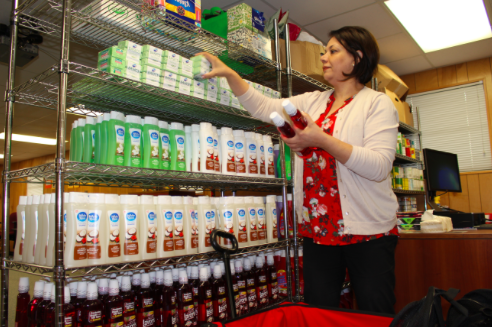HOUSTON – Officially launched at the start of the 2016-2017 school year, the Spring ISD Homeless Resource Center is helping to overcome some behind-the-scenes barriers to education regularly faced by students in the district.
The center, which is a joint effort between the district’s Federal and State Programs Department and Harris County Community Youth Services (CYS) caseworkers assigned to the district, provided backpacks, school supplies, school uniforms and personal hygiene products directly to almost 300 district students during the early weeks of the school year, and continues to serve additional homeless students weekly.
“The Homeless Resource Center represents one of the concrete ways our district is putting into practice its strategic plan, EVERY CHILD 2020, by working to reach every student and respond to their unique needs,” said Ambreen Ali, Spring ISD Title 1 coordinator and Homeless Resource Center administrator.
Like all public school districts, Spring ISD operates with a responsibility to provide an education to all the children it serves, no matter what barriers to access may exist for individual children and their families. The McKinney-Vento Homeless Assistance Act, a 1987 federal law aimed at protecting the educational stability of homeless students, establishes federal funding to help alleviate the effects of homelessness on children and young people. With nearly 37,000 students attending Spring ISD schools, teachers and administrators in the district face an ever-changing landscape of individual student situations and needs, and the challenge to respond proactively and effectively to these needs is always ongoing.
Through the use of Title 1 funds, the district, in conjunction with CYS caseworkers, has long assisted homeless students in need of clothing or supplies for school, but the process could often be lengthy and roundabout. Over the course of a six-month period leading up to the new school year, Ali spearheaded the effort to develop an in-house supply center that could meet the most basic and pressing needs of Spring ISD students dealing with the pressures of homelessness.
“I think many of the barriers to education faced by homeless students are social,” said Ali. “The idea is to try and remove those barriers as soon as possible.”
Establishing the center has eased the logistical strain and improved response times, Ali proudly points out, but it has also had other unexpected benefits that were not part of the original plan. In addition to supplies purchased directly by the district using Title 1 funds, donations made through Spring ISD’s Family and Community Engagement Department have also found their way to the resource center, where they can be stored and used later to help students as needed.
In another unplanned benefit, the center has developed a collection of gently used books that have been donated to the district and which Ali now includes in every backpack that CYS caseworkers hand out, so that, in addition to school supplies and personal care products, students will have reading materials available to them.
Citing the growing collection of books as an example, Ali said, “When you have a base, it allows you to grow bigger. It allows us to do things that we would never have thought to do if I was just operating out of my office. It makes us ask, ‘What else can we do?’”
“The other wonderful, amazing thing,” she continued, “is the amount of coordination, effort and support by other departments.” Chief Operations Officer Mark Miranda and his team stepped in to help find a physical home for the resources being gathered, employees from Distribution Services helped deliver clothing and supplies, and book lovers from around the district have been finding ways to gather more donated titles for the resource center’s shelves. “It’s really a collaborative effort,” says Ali, “between departments and across the district. You can’t do it solo.”
For students and families seeking Title 1 assistance through the district’s office of Federal and State Programs, the first step is getting in touch with campus counselors and filling out a Spring ISD Student Assistance Questionnaire, which will help to establish eligibility. In addition to school supplies, uniforms and personal hygiene products, the district also provides free meals at school for those who are eligible and assists some homeless students with transportation needs in order to help them stay at their home campus even when they or their families might be transient in response to their current living situation.
Those interested in learning how they can help support the Homeless Resource Center or related district initiatives are encouraged to contact the Family and Community Engagement Department at 281-891-6013.
Although the district’s work in addressing homelessness is ongoing, the results are encouraging. “I just feel it’s a labor of love,” said Ali in describing this year’s efforts to launch the Homeless Resource Center. “It’s been a really rewarding experience.”

